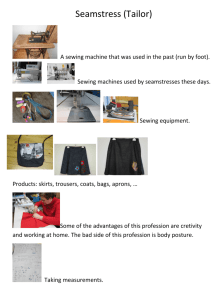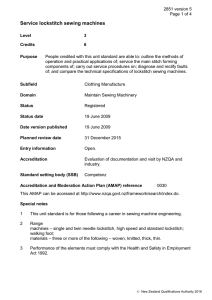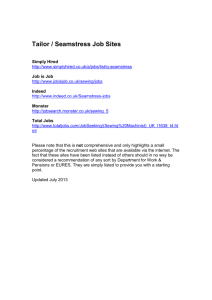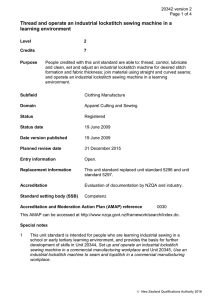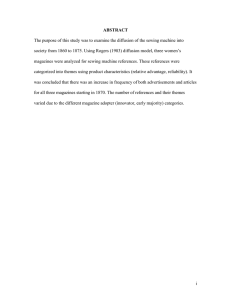Set up, adjust, and operate a domestic lockstitch sewing machine
advertisement
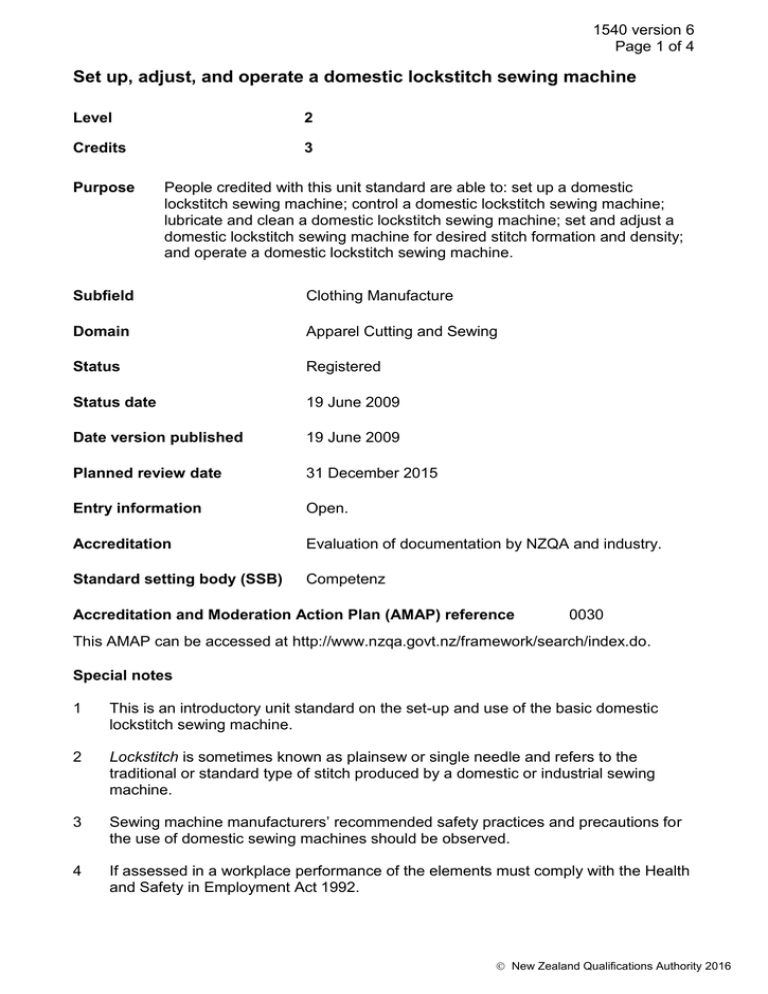
1540 version 6 Page 1 of 4 Set up, adjust, and operate a domestic lockstitch sewing machine Level 2 Credits 3 Purpose People credited with this unit standard are able to: set up a domestic lockstitch sewing machine; control a domestic lockstitch sewing machine; lubricate and clean a domestic lockstitch sewing machine; set and adjust a domestic lockstitch sewing machine for desired stitch formation and density; and operate a domestic lockstitch sewing machine. Subfield Clothing Manufacture Domain Apparel Cutting and Sewing Status Registered Status date 19 June 2009 Date version published 19 June 2009 Planned review date 31 December 2015 Entry information Open. Accreditation Evaluation of documentation by NZQA and industry. Standard setting body (SSB) Competenz Accreditation and Moderation Action Plan (AMAP) reference 0030 This AMAP can be accessed at http://www.nzqa.govt.nz/framework/search/index.do. Special notes 1 This is an introductory unit standard on the set-up and use of the basic domestic lockstitch sewing machine. 2 Lockstitch is sometimes known as plainsew or single needle and refers to the traditional or standard type of stitch produced by a domestic or industrial sewing machine. 3 Sewing machine manufacturers’ recommended safety practices and precautions for the use of domestic sewing machines should be observed. 4 If assessed in a workplace performance of the elements must comply with the Health and Safety in Employment Act 1992. New Zealand Qualifications Authority 2016 1540 version 6 Page 2 of 4 5 Definition Training Instructions refer to the guidelines and procedures, either written or oral, specified by the candidate's tutor/trainer in relation to the product or garment being sewn. These instructions must be made known to the candidate prior to assessment in this unit standard. Elements and performance criteria Element 1 Set up a domestic lockstitch sewing machine. Performance criteria 1.1 Old needles are removed and replaced with new ones to manufacturer’s specifications. 1.2 Domestic bobbins or spools are rewound, removed and replaced to manufacturer's specifications. 1.3 The domestic machine is threaded up to manufacturer's specifications, and tensions are set according to material to be sewn. Element 2 Control a domestic lockstitch sewing machine in accordance with manufacturer’s instructions. Performance criteria 2.1 Hand controls are used to change the direction of sewing. 2.2 The controls are used to lift the machine foot. 2.3 The foot pedal is used to change sewing speed. 2.4 The hand wheel is turned to sew to a precise point. Element 3 Lubricate and clean a domestic lockstitch sewing machine. Performance criteria 3.1 The domestic machine is switched off for all maintenance. 3.2 Parts are lubricated according to manufacturer's instructions using the recommended lubricants for a domestic machine. 3.3 All lint is removed from working parts to manufacturer's instructions for a domestic machine. New Zealand Qualifications Authority 2016 1540 version 6 Page 3 of 4 Element 4 Set and adjust a domestic lockstitch sewing machine for stitch formation and density in accordance with manufacturer’s instructions. Performance criteria 4.1 Stitch formation is drawn or explained correctly and the domestic machine adjusted for different stitch densities. 4.2 Relationship between top and bottom threads is correct and the importance explained for a domestic situation. 4.3 Faulty stitches are identified, and the domestic lockstitch sewing machine is adjusted to give a correct stitch in accordance with work instructions. 4.4 The domestic lockstitch sewing machine is correctly adjusted to give different stitch densities and the effects on quality, speed, and thread usage are briefly explained. Element 5 Join material using a straight seam. Performance criteria 5.1 Materials are stitched and removed from the domestic machine in accordance with training instructions. 5.2 The domestic machine is used at speed for long and short bursts of sewing. Please note Providers must be accredited by NZQA, or an inter-institutional body with delegated authority for quality assurance, before they can report credits from assessment against unit standards or deliver courses of study leading to that assessment. Industry Training Organisations must be accredited by NZQA before they can register credits from assessment against unit standards. Accredited providers and Industry Training Organisations assessing against unit standards must engage with the moderation system that applies to those standards. Accreditation requirements and an outline of the moderation system that applies to this standard are outlined in the Accreditation and Moderation Action Plan (AMAP). The AMAP also includes useful information about special requirements for organisations wishing to develop education and training programmes, such as minimum qualifications for tutors and assessors, and special resource requirements. New Zealand Qualifications Authority 2016 1540 version 6 Page 4 of 4 Comments on this unit standard Please contact Competenz info@competenz.org.nz if you wish to suggest changes to the content of this unit standard. New Zealand Qualifications Authority 2016
